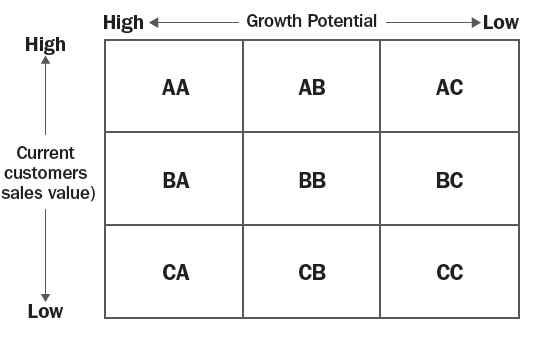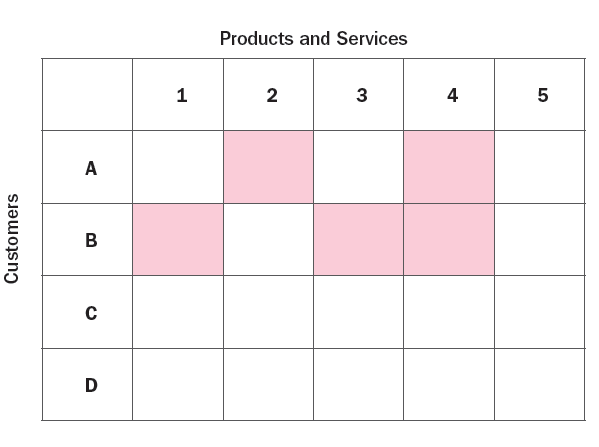Contents
- 1. Introduction
- 2. Developing new products and services
- 3. The multiplier effect
- 4. Increasing customer profitability
- 5. Maximising sales opportunities
1. Introduction
Customers are essential to any business – without customers, there is no business. The importance of marketing is covered in our 'marketing section' which focuses on sales and marketing as a tool for growth.
2. Developing new products and services
New products and services:
- give customers something fresh and new
- help you outsmart the competition
- fill a gap in the market
- even out peaks and troughs in demand
- help you to attract new customers
- help you maintain your competitive edge
The critical thing is to develop new products and services that your customers want and are willing to buy.
Talk to your customers to find out what their biggest problems and issues are. Now look at how you can help your customers to solve those problems and handle those issues.
See our 'What is Market Research' guide to find out what you need to know, and to steer your business in the right direction. Dig deep to find out exactly what your customers want.
See the features and benefits outlined in the 'What are you selling' guide to define your product or service and to assess the viability of those ideas in terms of developing new products and services.
If you provide a product to another business, it can be a good idea to ask if you can spend some time with your client to understand how they use your product. This may lead to new ideas for improving the product or finding solutions to problems, or maybe even to collaboration opportunities.
Customers are always looking for something new and different, so creating an ongoing flow of new offers, new packages, new variations and new packaging, as well as completely new products and services, ensures you remain at the forefront of your customers’ minds.
3. The multiplier effect
There are 3 ways you can grow your business:
1. get more customers
2. get customers to spend more
3. get customers to buy more frequently
A number of methods were highlighted in the 'What is Marketing' guide to help you achieve each of these. The guide also looked at the 4 Ps in business - Product, Price, Promotion and Place which will help you to keep customers for longer, another contributor to business growth.
Most businesses focus on just one area at a time, for example, increasing the number of customers. Let’s look at an example:
| Customers | Average Order Value (£) | Average Order Frequency | Turnover (£) |
|---|---|---|---|
| 100 | 100 | 2 | 20,000 |
| 110 | 100 | 2 | 22,000 |
You start off with 100 customers spending on average £100 per order. They order twice per year. Your total turnover is £20,000.
Now if you increase the number of customers by 10% you have 110 customers. If they spend £100 twice a year, your turnover increases from £20,000 to £22,000. This gives you linear growth of 10%.
However, if you work smart and increase in all 3 areas at the same time, you see the multiplier effect in action and achieve compound growth of both turnover and profits.
Let’s work through the example and increase each area by 10%
| Customers | Average Order Value (£) | Average Order Frequency | Turnover (£) |
|---|---|---|---|
| 100 | 100 | 2 | 20,000 |
| 110 | 110 | 2.2 | 26,620 |
In this example, you have increased the number of customers by 10% - from 100 to 110.
You have also increased the average order value by 10% from £100 to £110.
And you have increased the frequency your customers order by 10% from 2 to 2.2 times per year.
In total your turnover has increased from £20,000 to £26,620.
This is an increase in turnover of a massive 33.1%.and is compound growth.
How to achieve compound growth
To achieve compound growth, follow these 3 steps:
- list
- ask
- analyse
First, list all your main sources of lead generation.
Next, ask yourself what methods you used when you started the business and have now, perhaps, stopped using.
Finally, analyse how many leads you get from each source or method and the conversion rates.
Are there any new ideas you could use? In any business it’s worth testing new ideas. Test in a small way, and if it produces results roll it out to other areas of your business.
4. Increasing customer profitability
Most businesses know that a proportion of their customers are not profitable, but few admit that they should lose a customer in order to increase overall profitability. As with many other aspects of your business, the Pareto principle, often known as the 80-20 rule, can be applied to customer profitability.
In short, the Pareto principle means that 20% of your customers are likely to provide 80% of your profits. Also, 20% of your customers could be costing you 80% of your direct customer costs.
It makes sense to identify which of your customers are in which group and firstly, concentrate more on the top 20% and secondly, lose the bottom 20%.
Calculating customer profitability
Calculating customer profitability can be complex and requires detailed information and a trading history. However, a top-line analysis is still very useful.
Begin by looking at how much each customer spends with you and how often they buy (or how often you expect them to buy).
Be careful that you don’t assume that those who spend the most money with you are also your most valuable (or most profitable) customers. Think about the following:
- Do they buy high value, high margin products or services, or low value, low profit items?
- Do they place a number of large orders (instead of lots of small orders)?
- Do they keep changing or cancelling their orders?
- Do they pay on time without being chased for payment?
- Do they take up a lot of your time in after-sales service?
- Do they influence others’ buying decisions? For example, whilst one particular customer does not spend a great deal themselves, they frequently refer you to others who become new customers.
All of these factors contribute to the value of your customer and should be taken into account. For example, a profitable customer for a hairdresser could be someone who only has their hair styled on special occasions and spends a relatively small amount of money, but who also tells all her friends, some of whom have their hair done every month.
Work through your customer list and assess each customer for their value to your business. Rate them by turnover, their value to you, and also by their potential to grow.
Customer Profitability Grid
This grid is a useful tool to help you analyse your current customer base.

The vertical axis on the grid looks at the sales you get from current customers, from low at the bottom to high at the top.
The horizontal axis looks at the growth potential of customers, from low on the right to high on the left.
Those customers in the top left box – the AA customers - are those with highest sales and also the highest growth potential. This is where you should be spending the greatest amount of time and effort. Nurturing these relationships is important. Loyalty and VIP programmes are highly likely to produce positive returns. These customers are also your most positive advocates, so make sure you ask them for referrals and also get testimonials from them.
BB customers have average sales and are at the midpoint in terms of growth potential. With some effort and attention, you may be able to move these customers into the A category.
CC customers, those in the bottom right box, have low sales and are highly unlikely to ever buy more. There are your lowest 20% and you should not spend any time or effort working with them. Do not be concerned if they leave you, as they are costing you money.
In summary:
- AA customers are your star customers - your top 20%.
- AB and ACBA and CA customers are those with growth potential.
- BB, CB and BC customers – keep an eye on these as they may move up and become more valuable to you, or may just be costing your time, effort and money.
- CC customers are those that you ideally want to lose.
Use this template to help you determine your customers’ profitability (MS Word 20kb).
5. Maximising sales opportunities
One of the quickest and easiest ways to increase sales is to make sure that every one of your customers knows about all of the products and services you sell and has an opportunity to buy them.
Start with a simple chessboard diagram. On the left hand side, write down the names of each of your customers. The numbers along the top represent your products and services.

Now for each customer, colour in the appropriate square for each product or service they have bought.
In this example, you can see that Customer A has bought products 2 and 4, Customer B has bought products 1, 3 and 4 and so on.
The gaps that are left in your matrix are your windows of opportunity.
You’ve already spent money to attract those customers and you’ve already spent money developing the products and services. Now is the time to capitalise on that investment and put the 2 together.
There are 2 key action points:
- Make sure that every sales person in your business knows about all the products and services you have. If they are not talking about them, they are never going to sell them.
- Make sure that every customer knows about your full range of products and services. If they don’t know what you sell, they can’t buy.
Sales Opportunity Matrix
As well as helping you and your sales team focus your sales efforts, the sales opportunity matrix is valuable for several other reasons.
Penetration Rates: you can analyse the total penetration of products and services against your total customer base.
This is the number of coloured squares divided by total number of squares multiplied by 100.
For example, with 15 coloured squares out of a total of 24 squares, the equation would be 15/24 x 100 = 63%.
If you look at the penetration rate for each region or sales territory, you can identify where you need to target more effort.
Use this information and estimate when customers are likely to buy - this can help you put more accurate sales forecasts together.
Block the competition: once your customers start to buy more of your range, then you are more likely to block your competition. The more reliant your customers are on you for supply and the wider that supply, the less likely they are to move to a new supplier.
Use this create your sales opportunity matrix (MS Word 15kb) template to identify your windows of opportunity.
